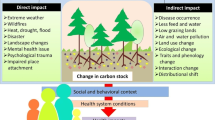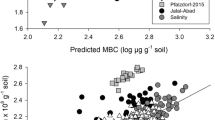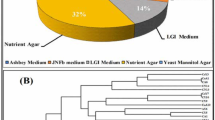Abstract
Imidacloprid, used against mango hopper, is a persistent insecticide in soil. Microbes have the ability to remove toxic pesticides from soil surface. Metagenomic is an approach for understanding the diversity and related metabolic activities in any environmental sample without culturing the microbes. Metagenomic analysis of mango orchard soil was carried out using 16S rRNA gene sequencing to understand the impact of imidacloprid on soil microbial population. In control and imidacloprid applied soil samples, representative sequences clustered were 0.142930 and 0.082320 million, respectively. At the kingdom level, 85 and 88 percent represented to bacteria, 2 and 1 percent to archaea, and 13 and 11 percent to unassigned for control and treated metagenomes, respectively. At phylum level, 16 and 17 percent of OTUs (operational taxonomic units) were assigned with Proteobacteria, while 13 and 11 percent of OTUs were unassigned in control and imidacloprid-treated samples, respectively. The other abundant phyla in both the samples were Planctomycetes, Bacteroidetes, and Actinobacteria. At class level, 9 and 11 percent of OTUs were assigned with Planctomycetia in control as well as imidacloprid-treated samples, respectively. A number of OTUs present in control and imidacloprid applied samples are 31,173 and 21,909, respectively, with 18,018 number of OTUs shared between the two samples. The genus Gemmata totally disappeared in imidacloprid applied soil, while those belonging to class Phycisphaerae, genus Prevotella and species copri were identified in imidacloprid treatment. Bacterial community transformation was evident from this study indicating possible microbial bioremediation of imidacloprid in mango orchard soil.





Similar content being viewed by others
Data availability
Not applicable.
References
Ahmed, S., & Ahmad, M. S. (2006). Effect of insecticides on the total number of soil bacteria under laboratory and field conditions. Pakistan Entomology, 28, 63–68.
Amann, R. I., Ludwig, W., & Schleifer, K. H. (1995). Phylogenetic identification and in situ detection of individual microbial cells without cultivation. Microbiological Reviews, 59(1), 143–169.
Andrews, S. (2017). FastQC: A quality control tool for high throughput sequence data. http://www.bioinformatics.babraham.ac.uk/projects/fastqc/. Accessed 3 May 2017.
Anhalt, J. C., Moorman, T. B., & Koskinen, W. C. (2007). Biodegradation of imidacloprid by an isolated soil microorganism. Journal of Environmental Science and Health. Part. B, 42(5), 509–514.
Anonymous (2010). Management of mango hopper. http://www.cishlko.org/Technologies/MangoHopper_advisory.pdf. Accessed 10 August 2011.
Astaykina, A. A., Streletskii, R. A., Maslov, M. N., Belov, A. A., Gorbatov, V. S., & Stepanov, A. L. (2020). The impact of pesticides on the microbial community of agrosoddy-podzolic soil. Eurasian Soil Science, 53, 696–706. https://doi.org/10.1134/S1064229320050038.
Babraham Bioinformatics – TrimGalore! (2017). Available from: https://www.bioinformatics.babraham.ac.uk/projects/trim_galore/. Accessed 3 May 2017.
Baskaran, S., Kookana, R. S., & Naidu, R. (1997). Determination of the insecticide imidacloprid in water and soil using high performance liquid chromatography. Journal of Chromatography. A, 787, 271–275. https://doi.org/10.1016/S0021-9673(97)00652-3.
Bhardwaj, P., Singh, K. R., Jadeja, N. B., Phale, P. S., & Kapley, A. (2020). Atrazine bioremediation and its influence on soil microbial diversity by metagenomics analysis. Indian Journal of Microbiology, 60, 388–391. https://doi.org/10.1007/s12088-020-00877-4.
Bhattacherjee, A. K., Garg, N., Shukla, P. K., Singh, B., Vaish, S., & Dikshit, A. (2020). Bacterial bioremediation of imidacloprid in mango orchard soil by Pseudomonas mosselii strain NG1. International Journal of Current Microbiology and Applied Sciences, 9(10), 1150–1159. https://doi.org/10.20546/ijcmas.2020.910.138.
Caporaso, J. G., Kuczynski, J., Stombaugh, J., Bittinger, K., Bushman, F. D., Costello, E. K., Fierer, N., Peña, A. G., Goodrich, J. K., Gordon, J. I., Huttley, G. A., Kelley, S. T., Knights, D., Koenig, J. E., Ley, R. E., Lozupone, C. A., McDonald, D., Muegge, B. D., Pirrung, M., Reeder, J., Sevinsky, J. R., Turnbaugh, P. J., Walters, W. A., Widmann, J., Yatsunenko, T., Zaneveld, J., & Knight, R. (2010). QIIME allows analysis of high throughput community sequencing data. Nature Methods, 7(5), 335–336. https://doi.org/10.1038/nmeth.f.303.
Cycoń, M., & Piotrowska-Seget, Z. (2015a). Biochemical and microbial soil functioning after application of the insecticide imidacloprid. Journal of Environmental Sciences, 27(1), 147–158. https://doi.org/10.1016/j.jes.2014.05.034.
Cycoń, M., & Piotrowska-Seget, Z. (2015b). Community structure of ammonia-oxidizing archaea and ammonia-oxidizing bacteria in soil treated with the insecticide imidacloprid. Journal of Biomedicine & Biotechnology, 582938, 1–12. https://doi.org/10.1155/2015/582938.
Cycoń, M., Markowicz, A., Borymski, S., Wójcik, M., & Piotrowska-Seget, Z. (2013). Imidacloprid induces changes in the structure, genetic diversity and catabolic activity of soil microbial communities. Journal of Environmental Management, 131, 55–65. https://doi.org/10.1016/j.jenvman.2013.09.041.
DeSantis, T. Z., Hugenholtz, P., Larsen, N., Rojas, M., Brodie, E. L., Keller, K., Huber, T., Dalevi, D., Hu, P., & Andersen, G. L. (2006). Greengenes, a Chimera-checked 16S rRNA gene database and workbench compatible with ARB. Applied and Environmental Microbiology, 72(7), 5069–5072. https://doi.org/10.1128/AEM.03006-05.
Doolotkeldieva, T., Konurbaeva, M., & Bobusheva, S. (2018). Microbial communities in pesticide-contaminated soils in Kyrgyzstan and bioremediation possibilities. Environmental Science and Pollution Research, 25, 31848–31862. https://doi.org/10.1007/s11356-017-0048-5.
Edgar, R. C., Haas, B. J., Clemente, J. C., Quince, C., & Knight, R. (2011). UCHIME improves sensitivity and speed of chimera detection. Bioinformatics, 27(16), 2194–2200. https://doi.org/10.1093/bioinformatics/btr38.
Goulson, D. (2013). An overview of the environmental risks posed by neonicotinoid insecticides. Journal of Applied Ecology, 50(4), 977–987. https://doi.org/10.1111/1365-2664.12111.
Hugenholtz, P., & Tyson, G. W. (2008). Microbiology: metagenomics. Nature, 455, 481–483. https://doi.org/10.1038/455481a.
Jeffries, T. C., Rayu, S., Nielsen, U. N., Lai, K., Ijaz, A., Nazaries, L., & Singh, B. K. (2018). Metagenomic functional potential predicts degradation rates of a model organophosphorus xenobiotic in pesticide contaminated soils. Frontiers in Microbiology, 9, 147. https://doi.org/10.3389/fmicb.2018.00147.
Kim, D., Kim, Y. S., Kim, S. K., Kim, S. W., Zylstra, G. J., Kim, Y. M., & Kim, E. (2002). Monocyclic aromatic hydrocarbon degradation by Rhodococcus sp. strain DK17. Applied and Environmental Microbiology, 68, 3270–3278. https://doi.org/10.1128/aem.68.7.3270-3278.2002.
Klindworth, A., Pruesse, E., Schweer, T., Peplies, J., Quast, C., Horn, M., & Glöckner, F. O. (2013). Evaluation of general 16S ribosomal RNA gene PCR primers for classical and next-generation sequencing-based diversity studies. Nucleic Acids Research, 41(1), e1. https://doi.org/10.1093/nar/gks808.
Kumar, A., & Singh, J. S. (2017). Cyanoremediation: A green-clean tool for decontamination of synthetic pesticides from agro- and aquatic ecosystems. In J. Singh & G. Seneviratne (Eds.), Agro-environmental sustainability (pp. 59–83). Cham: Springer. https://doi.org/10.1007/978-3-319-49727-3_4.
Kuritz, T. (1998). Cyanobacteria as agents for the control of pollution by pesticides and chlorinated organic compounds. Journal of Applied Microbiology Symposium Supplement, 85, 186S–192S.
Kuczynski, J., Stombaugh, J., Walters, W. A., González, A., Caporaso, J. G., & Knight, R. (2011). Using QIIME to analyze 16S rRNA gene sequences from microbial communities. Current Protocols in Bioinformatics, Chapter 10, Unit 10.7–10.7. https://doi.org/10.1002/0471250953.bi1007s36.
Li, C., Zhang, J., Wu, Z. G., Cao, L., Yan, X., & Li, S. P. (2012). Biodegradation of buprofezin by Rhodococcus sp. strain YL-1 isolated from rice field soil. Journal of Agricultural and Food Chemistry, 60(10), 2531–2537. https://doi.org/10.1021/jf205185n.
Langille, M. G. I., Zaneveld, J., Caporaso, J. G., McDonald, D., Knights, D., Reyes, J., et al. (2013). Predictive functional profiling of microbial communities using 16S rRNA marker gene sequences. Nature Biotechnology, 8, 1–10. https://doi.org/10.1038/nbt.2676.
Metagenome of mango orchard soil (n.d.) https://submit.ncbi.nlm.nih.gov/subs/sra/SUB6674392/ overview.
Microbiome Analyst (n.d.) Comprehensive statistical, visual and meta-analysis of microbiome data. https://www.microbiomeanalyst.ca/faces/home.xhtml
Moghaddam, N. S., Zakaria, M. P., Omar, D., Sijam, K., & Khakvar, R. (2011). Effects of imidacloprid on the biodiversity of soil microbes in selected soils of Malaysia. 2nd International Conference on Environmental Science and Development, IPCBEE, 4, 7-10.
Muturi, E. J., Donthu, R. K., Fields, C. J., Moise, I. K., & Kim, C. H. (2017). Effect of pesticides on microbial communities in container aquatic habitats. Scientific Reports, 7, 44565. https://doi.org/10.1038/srep44565.
Pseudomonas mosselii (n.d.) strain NG1 16S ribosomal RNA gene, partial sequence. https://www.ncbi.nlm.nih.gov/nuccore/1736685383
Sangwan, N., Lata, P., Dwivedi, V., Singh, A., Niharika, N., Kaur, J., Anand, S., Malhotra, J., Jindal, S., Nigam, A., Lal, D., Dua, A., Saxena, A., Garg, N., Verma, M., Kaur, J., Mukherjee, U., Gilbert, J. A., Dowd, S. E., Raman, R., Khurana, P., Khurana, J. P., & Lal, R. (2012). Comparative metagenomic analysis of soil microbial communities across three hexachlorocyclohexane contamination levels. PLoS ONE, 7(9), e46219. https://doi.org/10.1371/journal.pone.0046219.
Sarkar, M. A., Roy, S., Kole, R. K., & Chowdhury, A. (2001). Persistence and metabolism of imidacloprid in different soils of West Bengal. Pest Management Science, 57, 598–602. https://doi.org/10.1002/ps.328.
Shah, V., Jain, K., Desai, C., & Madamwar, D. (2012). Molecular analyses of microbial communities involved in bioremediation. In T. Satyanarayana & B. N. Johri (Eds.), Microbes in environmental management and biotechnology (pp. 221–247). Amsterdam: Springer.
Shah, V., Zakrzewski, M., Wibberg, D., Eikmeyer, F., Schlüter, A., & Madamwar, D. (2013). Taxonomic profiling and metagenome analysis of a microbial community from a habitat contaminated with industrial discharges. Microbial Ecology, 66(3), 533–550. https://doi.org/10.1007/s00248-013-0253-9.
Shetti, A. A., & Kaliwal, B. B. (2016). Effect of imidacloprid on bacterial soil isolate Bacillus weihenstephanensis. In S. Trdan (Ed.), Insecticides resistance (pp. 275–294). Slovenia: IntechOpen. https://doi.org/10.5772/61503.
Singh, J., & Singh, D. K. (2005). Bacterial, azotobacter, actinomycetes, and fungal population in soil after diazinon, imidacloprid, and lindane treatments in groundnut (Arachis hypogaea L.) fields. Journal of Environmental Science and Health. Part. B, 40(5), 785–800. https://doi.org/10.1080/03601230500189725.
Sphingobacterium mucilaginosum (n.d.) strain NG201 16S ribosomal RNA gene, partial sequence. https://www.ncbi.nlm.nih.gov/nuccore/1783385310
Starner, K., & Goh, K. S. (2012). Detections of imidacloprid in surface waters of three agricultural regions of California, USA, 2010-2011. Bulletin of Environmental Contamination and Toxicology, 88(3), 316–321. https://doi.org/10.1007/s00128-011-0515-5.
Wang, F., Yao, J., Chen, H., Yi, Z., & Choi, M. M. F. (2014). Influence of short-time imidacloprid and acetamiprid application on soil microbial metabolic activity and enzymatic activity. Environmental Science and Pollution Research, 21, 10129–10138. https://doi.org/10.1007/s11356-014-2991-8.
Yousaf, S., Khan, S., & Aslam, M. (2013). Effect of pesticides on the soil microbial activity. Pakistan Journal of Zoology, 45, 1063–1067.
Zhang, Q., Xue, C., & Wang, C. (2015). Effects of imidacloprid on soil microbial communities in different saline soils. Environmental Science and Pollution Research, 22, 19667–19675. https://doi.org/10.1007/s11356-015-5154-7.
Code availability
Software codes are provided in the materials and methods section.
Funding
The authors are grateful to the Council of Science & Technology, Uttar Pradesh, Lucknow, India, for providing financial support of the present study in the form of a project grant vide Council’s Letter No. CST/AAS/D-1542 dated 02/08/2017.
Author information
Authors and Affiliations
Corresponding author
Ethics declarations
Conflict of interest
The authors declare that they have no conflict of interest.
Additional information
Publisher’s note
Springer Nature remains neutral with regard to jurisdictional claims in published maps and institutional affiliations.
Rights and permissions
About this article
Cite this article
Garg, N., Bhattacherjee, A.K., Shukla, P.K. et al. Influence of imidacloprid on bacterial community diversity of mango orchard soil assessed through 16S rRNA sequencing-based metagenomic analysis. Environ Monit Assess 193, 102 (2021). https://doi.org/10.1007/s10661-021-08885-7
Received:
Accepted:
Published:
DOI: https://doi.org/10.1007/s10661-021-08885-7




